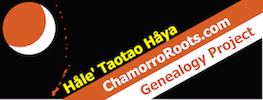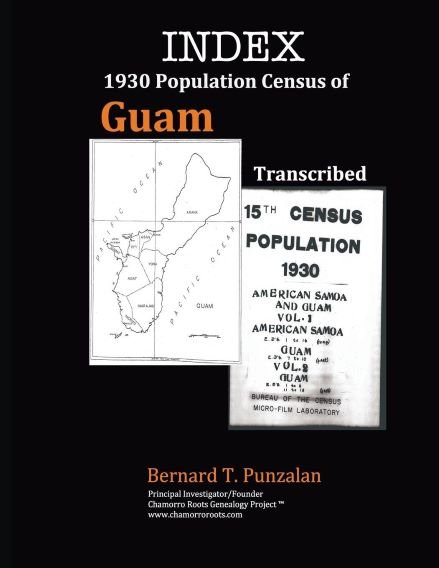Home
Workshop Guest Speakers
- Details
- Written by: Bernard Punzalan
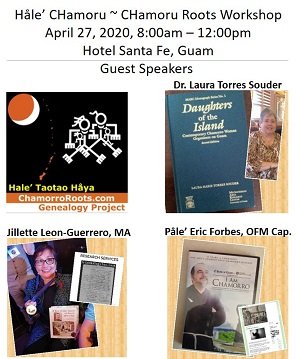
|
Yes, I would like to attend the workshop. Light lunch included. Reserve my seat. |
No, I will not be able to attend but would like to take advantage of the promotion special for a one-year access to the database and four (4) census eBooks. |
Ok folks, right now I have blessed to secure an awesome trifecta of guest speakers for the Håle' CHamoru - CHamoru Roots Workshop, April 27, 2020, 8:00am-12pm, Hotel Santa Fe, Guam.
Dr. Laura Torres Souder, CHamoru historian, former museum curator, and author of “Daughters of the Island: Contemporary Chamorro Women Organizers on Guam," 1987.
Jillette Torre Leon-Guerrero, MA, CHamoru historian and genealogist, owner of Guamology Inc., gold medalist winner for publishing “A Year on the Island of Guam,” 2019.
Påle’ Eric Forbes, OPM Cap., CHamoru historian and genealogist, who was featured and narrated the documentary video, “I Am Chamorro,” 2015.
Seating is very limited. I encourage you to reserve your seat in advance by clicking on the following link: https://www.chamorroroots.com/v7/index.php/75-workshop/645-chamorro-roots-genealogy-project-workshop-announcement-2
More about Dr. Laura Torres Souder:
https://www.guampedia.com/laura-t-souder/
More about Jillette Leon-Guerrero:
https://www.guampedia.com/jillette-leon-guererro/
More about Påle’ Eric:
https://www.guampedia.com/eric-forbes/
Finding Apolonia
- Details
- Written by: Jillette Leon-Guerrero, MA
Introduction
Proving the parentage of individuals born in Guam during the 1800s is difficult, and in some cases, appears impossible. Finding any written documentation for those born during this period is a challenging endeavor. This is because much of the written documentation for this period did not survive. Guam’s turbulent history, the tropical climate and the devastation of World War II are responsible for the dearth of information.[1],[2] This presents a challenge to genealogists and requires them to use creative strategies to assemble evidence in support of their research. Unless a hidden cache of historical documents is found to bridge this gap, this will continue to confound genealogists and historians for years to come.
In Guam, many families do not know much about their ancestors that lived in the early 1800s. One significant event that may have contributed to this situation was the worldwide influenza pandemic in 1918-19. Brought to Guam onboard the military transport ship the USS Logan, the “Spanish Flu” killed over 6% of the island population.[3] The very young and the elderly were especially vulnerable. Because of the high rate of mortality in the elderly, it has been said that over 80% of those who spoke Spanish perished because of the epidemic.[4] While this event brought an abrupt halt to the use of the Spanish language on Guam, it is also believed to have hindered the transmission of family histories from one generation to the next. For today’s elderly, it is not uncommon for Guam residents to not know who their great grandparents were. For those that do, they know very little about their lives. This was the case with Apolonia Ada.
Reproduced by permission of the Author for research and educational purposes.
[1] Safford, W.E., “The Mariana Islands Notes compiled by W. E. Safford: From Documents in the Archives at Agaña, the Capital of Guam, from early Voyages found in the Libraries of San Francisco, California,” (bound transcript 1901, Micronesian Area Research Center, University of Guam) p. IV-V.
[2] O.R. Lodge, “Attach Preparations,” The Recapture of Guam, (Fredericksburg: Awani Press Inc., 1988), 33.
[3] Shanks, G.D., Hussell, T. and Brundage, “Epidemiological isolation causing variable mortality in island populations during the 1918-1920 influenza pandemic”, Influenza and Other Respiratory Viruses, 6 (January 2012) 417-423.
[4] Julius Sullivan, “Men of Navarre,” The Phoenix Rises (New York: Seraphic Mass Association, 1957), 118-119.
Håle' CHamoru - CHamoru Roots Workshop Announcement
- Details
- Written by: Bernard Punzalan

|
Yes, I would like to attend the workshop. Light lunch included. Reserve my seat. |
No, I will not be able to attend but would like to take advantage of the promotion special for a one-year access to the database and four (4) census eBooks. |
This a one-time promotional special offer for those who would like to attend the first Chamorro Roots Genealogy Project Workshop and those unable to attend but are interested in taking advantage of this special offer:
What: Håle' CHamoru - CHamoru Roots Workshop
Who: Conducted by Bernard Punzalan, Founder
Where: Hotel Santa Fe, Tamuning, Guam
When: April 27, 2020 (8:00am-12:00pm)
Note: Registration is limited to 10 per workshop and a minimum of 5 to recover venue costs. Workshop attendees should bring their laptops or tablets for hands-on support and assistance. I realize that not everyone will be able to attend the Workshop, so I added an option for those who cannot attend but would like to take advantage of saving $75 (one-year subscription and four Guam Census eBooks). There will only be 20 of this special price promotion offering and will be on a first come first served basis.
Registration includes:
- One-year subscription to the on-line Chamorro Roots Genealogy Project ($60 value)
- Four (4) eBooks ($115 value) – 1920 and 1930 Census transcription eBooks; and, 1920 and 1930 Census Index eBooks
- Light refreshments for Workshop atttendees
- Proceeds are to help with costs to sustain the Project, si Yu'os ma'ase.
Once purchased the download links will be available on your "Store Purchases" menu for each of the files. The download link will be available for 90 days from the date of purchase. Because access to download these eBooks will be immediately available upon purchase no refunds can be made.
For access to the Chamorro Roots Genealogy Project database and other eBook resources, I will notify you of availability once I have fully completed integrating your registration purchase.
CHamoru Genealogy, Identity and Its Impact from U.S. Census Questionnaires
- Details
- Written by: Bernard Punzalan
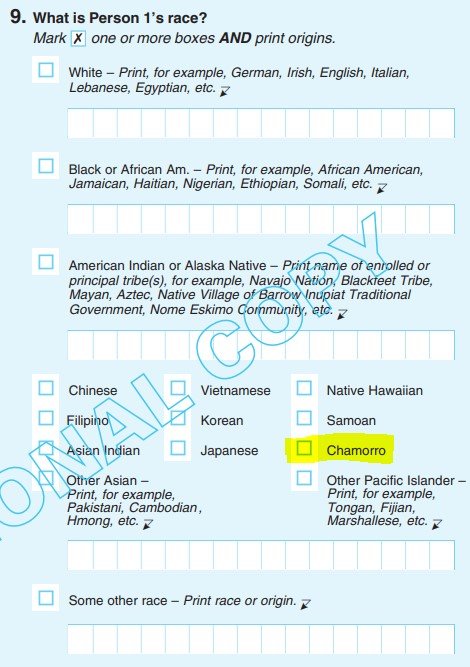
Figure 1. 2020 U.S. census questionnaire
For the first time in Guam and Commonwealth of the Mariana Islands (CNMI) history, the 2020 Census produced the first questionnaire that does not distort the ethnicity/race of the “Chamorro” people. In order to get a better understanding to certain components of this issue, one must learn the political and colonial history of the partition of the Mariana Islands, Guam from its sister islands. Below is a short historical summary that has affected the true population count of the CHamoru people under the U.S.
Guam was ceded by Spain and became a colony of the U.S. in 1898. As for the rest of the Mariana Islands, Spain sold them to Germany after the Spanish-American war in 1898, but they did not become a U.S. colony until after World War II against Japan. After all the war and turmoil between colonial empires, the first U.S. decennial population of Guam did not occur until 1920, while the CNMI was not included until 1970.
From 1920 – 1960, the U.S. census questionnaires were completed by census enumerators, which left them with the power of the pen in recording how names and family information were recorded. Some included spelling variations among other transcription errors. But in 1970, the U.S. census questionnaires became self-enumerated, which gave the power of the pen back to the owners of information. There was also a blank space to write-in “Chamorro,” as a “Color or Race.”
Come 1980, the U.S. census questionnaire for Guam as an unincorporated territory of the U.S., and for the first time, included the term “Guamanian” as a race. This term reinforced a negative stigma from World War II and exacerbated the partition of the CHamoru people between Guam and the CNMI. On the other hand, the census questionnaire used for the rest of the Mariana Islands, at the time a U.S. Trust Territory of the Pacific Islands, was more specific and one could write-in “Chamorro.”
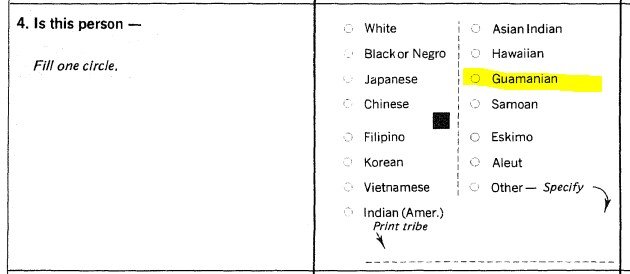
Figure 2. 1980 ethnic census option for Chamorro people residing on Guam or U.S.

Figure 3. 1980 ethnic census option for Chamorro people residing in Northern Mariana Islands or other Trust Territories
In the 1990 census questionnaire “Asian or Pacific Islander (API)” was introduced and again included “Guamanian” as an option and added “Other API” with a space to write-in a race. However in the 2000 and 2010 census, enter the “Guamanian or Chamorro,” option. Sigh…
So when the opportunity comes, please ensure that you and your family are among those enumerated in the 2020 census. One important reason to do so is that the data will be analyzed and typically used for decision making purposes. Therefore, depending on the nature and what type of decision may need to be made, will be contingent and dependent on the data collected to date. If one does not have the appropriate data, s/he might not be able to make a more suitable decision that can impact the lives of many. In particular, a faulty decision could result in an adverse impact/unintended consequence of loss of benefits, programmatic or funding opportunities, and the list can go on.
And finally, we must never forget that we are an ethnically and culturally unique people in this world. This is all a part of the Chamorro Roots Genealogy Project.
CHamoru-ham maseha månu gaige ham! [We are CHamoru, no matter where we may be!]
See also: Is "Guamanian" an Ethnic Race?
Project Updates/Upgrades in Progress/Status
- Details
- Written by: Bernard Punzalan

Håfa Adei!
For the past few months I have been working on system updates and technology advances to benefit the Project in the near future. I must admit that it’s taking me much longer than expected. As technological advances continue at a light speed pace, I am not as quick to assess impact and keep up with the changes. But rest assured, I do my best to ensure that the system remains accessible and security of the data remains in tact.
The biggest side project for me has been trying to configure, sustain and run a private cloud server parallel with what you see on-line. I hope to complete that project within the next few months and demonstrate its capabilities that will also help me to reduce many of the time consuming work-arounds just to maintain for the Project’s current server.
I will also be on Guam from April 23 to May12, 2020. When I am there I hope to be able to conduct a hands-on Chamorro Roots Genealogy Project workshop. I am almost finished with the planning on that event and will announce it soon.
I also want to thank everyone who has either subscribed or donated to keep this project on-line.
Miggai ma’åse nu hamyu!
Bernard
Page 24 of 83
